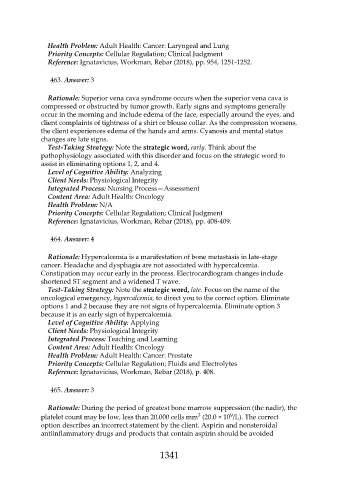Page 1341 - Saunders Comprehensive Review For NCLEX-RN
P. 1341
Health Problem: Adult Health: Cancer: Laryngeal and Lung
Priority Concepts: Cellular Regulation; Clinical Judgment
Reference: Ignatavicius, Workman, Rebar (2018), pp. 954, 1251-1252.
463. Answer: 3
Rationale: Superior vena cava syndrome occurs when the superior vena cava is
compressed or obstructed by tumor growth. Early signs and symptoms generally
occur in the morning and include edema of the face, especially around the eyes, and
client complaints of tightness of a shirt or blouse collar. As the compression worsens,
the client experiences edema of the hands and arms. Cyanosis and mental status
changes are late signs.
Test-Taking Strategy: Note the strategic word, early. Think about the
pathophysiology associated with this disorder and focus on the strategic word to
assist in eliminating options 1, 2, and 4.
Level of Cognitive Ability: Analyzing
Client Needs: Physiological Integrity
Integrated Process: Nursing Process—Assessment
Content Area: Adult Health: Oncology
Health Problem: N/A
Priority Concepts: Cellular Regulation; Clinical Judgment
Reference: Ignatavicius, Workman, Rebar (2018), pp. 408-409.
464. Answer: 4
Rationale: Hypercalcemia is a manifestation of bone metastasis in late-stage
cancer. Headache and dysphagia are not associated with hypercalcemia.
Constipation may occur early in the process. Electrocardiogram changes include
shortened ST segment and a widened T wave.
Test-Taking Strategy: Note the strategic word, late. Focus on the name of the
oncological emergency, hypercalcemia, to direct you to the correct option. Eliminate
options 1 and 2 because they are not signs of hypercalcemia. Eliminate option 3
because it is an early sign of hypercalcemia.
Level of Cognitive Ability: Applying
Client Needs: Physiological Integrity
Integrated Process: Teaching and Learning
Content Area: Adult Health: Oncology
Health Problem: Adult Health: Cancer: Prostate
Priority Concepts: Cellular Regulation; Fluids and Electrolytes
Reference: Ignatavicius, Workman, Rebar (2018), p. 408.
465. Answer: 3
Rationale: During the period of greatest bone marrow suppression (the nadir), the
9
3
platelet count may be low, less than 20,000 cells mm (20.0 × 10 /L). The correct
option describes an incorrect statement by the client. Aspirin and nonsteroidal
antiinflammatory drugs and products that contain aspirin should be avoided
1341

